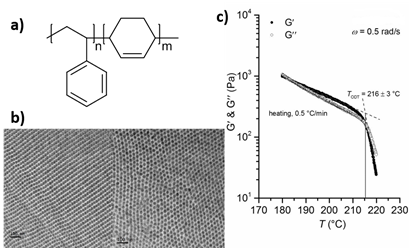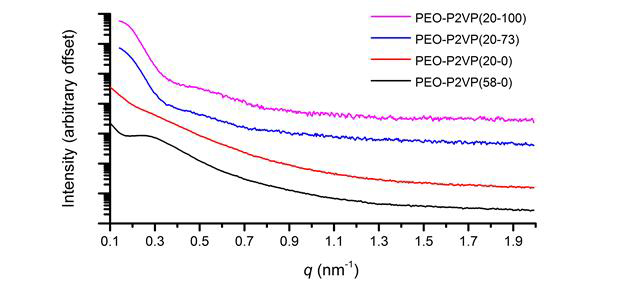Reports: DNI755378-DNI7: Petroleum Derived Triblock Terpolymer Templates for Dual-Metal Patterning of Square-Patterned Rectangular Nanostructures
Justin G. Kennemur, PhD, Florida State University
STUDENT AND PRINCIPLE INVESTIGATOR IMPACT
The 2016-2017 year faced some notable accomplishments and minor adversities. The graduate student being supported by this project successfully defended his preliminary exam and officially became a Ph.D. Candidate in the Fall of 2016. However, in early 2017, this student faced some medical complications that required surgery and a temporary leave from graduate school. The student successfully completed surgery rehabilitation and returned to his graduate studies in the early summer of 2017 and is now working full time on the project again. Financial support for the student will be extended into the 2018 year to make-up for the time lost. The student’s growth as a scholar and researcher continues to improve thanks to the support of this grant.
Undergraduate student support from this grant was applied to a promising rising Junior chemistry major during the summer of 2017. This student is now participating in the Undergraduate Honors Thesis Program with the PI being her thesis advisor thanks to the summer research that was supported by this grant.
The PI, now entering the 4th year as an Assistant Professor has also grown as a faculty mentor and research advisor during this period. The PI’s research group has now grown to six graduate students and peer-reviewed publications in top polymer science journals are now being produced with the work partially supported and acknowledged by this grant. The PI was an invited speaker at the Fall 2017 ACS National Meeting in Washington DC and travel funds supported by this grant were used to attend this conference.
RESEARCH PROGRESS
The overarching aims of this research proposal are to investigate the rich field of microphase separation phenomena between block polymer segments. The following progress has been made:
(1) Collaborative Project on the Interaction Parameter of Block Polymers Containing Polystyrene and Poly(1,3-cyclohexadiene) segments.
Partial support from this grant went towards a collaborative publication between the PI and several other leaders in the field polymer synthesis and block polymers including collaboration between scientists at Oak Ridge National Laboratory. Within this report, it was discovered that microphase separation behavior of linear diblock polymers containing poly(1,3-cyclohexadiene) (PCHD) with high 1,4-microstructure and polystyrene (PS) resulted in complex out-of-equilibrium morphologies due to the high conformational asymmetry between PS and PCHD. Rheological measurements, performed by the PI, revealed an order-to-disorder transition temperature for these systems for the first time. This, in turn, allowed determination of a working expression for the effective Flory-Huggins interaction parameter (χeff) between these segments (χeff = 32/T -0.016).
Figure 1. PS-block-1,4-PCHD copolymer a) chemical structure, b) transmission electron tomography (TEM) images displaying varying morphologies, and c) rheology analysis showing an isochronal temperature ramp and an order-to-disorder transition at 216 ± 3 °C indicated by a sudden decrease in dynamic elastic and storage modulus (G′ & G′′).
(2) Progress towards poly(ethylene oxide-block-styrene-block-2-vinylpyridine) with alternating cylindrical morphologies.
A main goal of the proposed work is the investigation of linear triblock terpolymers containing a central PS block flanked by a segments of polyethylene oxide (PEO) and poly(2-vinylpyridine) (P2VP). This segment sequencing was desired to obtain a microphase separated morphology of alternating PEO and P2VP cylinders within an inert PS matrix. Precedence in literature has shown that block polymer systems containing PEO and P2VP segments effectively serve as selective hosts for oppositely charged metal salts, and therefore this morphology could provide templates of alternating metallic nanostructures. In our first report we successfully showed the synthesis and characterization of a set of PEO-PS-P2VP triblock terpolymers. Although χeff between PS and PEO (χPS/PEO) and between PS and P2VP (χPS/P2VP) is known to be sufficiently large to allow microphase separation at modest molar masses, it was soon discovered that the segregation strength between PEO and P2VP (χPEO/P2VP) is quite weak and, to the best of our knowledge, still unknown. Given the importance and widespread use of these segments in block polymer literature, we deemed it important to redirect our investigations on PEO-b-P2VP diblock copolymers to gain insight on χPEO/P2VP. New materials were synthesized through reversible-addition fragmentation-transfer (RAFT) polymerization of P2VP segments from a PEO macroinitiator containing a chain transfer agent (CTA) functionality at one chain end. Preliminary in-house small angle x-ray scattering (SAXS) analysis reveals that symmetric (near equal volume fraction, f) PEO-P2VP systems remain largely disordered up to 58 kg mol-1 (Figure 2) with the slight appearance of correlation hole scattering at 58 kg mol-1. Attempts to increase the interaction parameter and drive microphase separation were performed through quarternization of the P2VP segment with methyl iodide. Symmetric PEO-P2VP systems with a molar mass ~ 20 kg mol-1 remain ordered at P2VP quarternization levels of 0, 75, and 100% (Figure 2).
CURRENT DIRECTIONS
The upcoming year is envisioned to make large strides with respect to our understanding of χeff between PEO and P2VP segments in addition to PEO/P4VP segments. A request for beamtime at Argonne National Laboratory to use the high energy synchrotron source has been approved. With this capability, definitive understanding on the ordering of these segments will be revealed. A large library of symmetric PEO-P2VP and PEO-poly(4-vinylpyridine) (P4VP) systems of increasing molar mass are already being synthesized and, for some of the samples, the P2VP and P4VP segments are being quarternized to test the tunability of χeff through this ionization strategy. Once the required size of the PEO and P2/4VP segments necessary for ordering are realized, they can be implemented into the original ABC triblock terpolymers design to accomplish the alternating cylindrical morphology originally targeted.
Figure 2. Small-angle x-ray scattering (SAXS) overlay of PEO-P2VP diblock polymer samples. The numbers within the parenthesis (x-y) represents; x – the total molar mass of the diblock copolymer and y- the percent quarternization of the pyridinyl groups using methyl iodide. All materials have a nearly symmetrical volume fraction of the PEO and P2VP segments.













